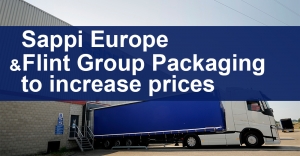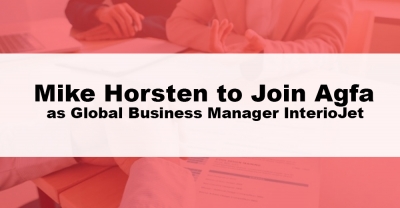Search
Sappi Europe and Flint Group Packaging to increase prices
Sappi Europe will increase prices of all of its Packaging and Speciality paper grades by 7%-11%, valid for deliveries from 1 April 2021.
In a statement, the paper manufacturer said: “Sharply rising input costs, particularly relevant to pulp and energy in combination with very high freight rates due to global logistic constraints make price increases unavoidable.
In January, the company had already announced an increase to the price of its coated and uncoated woodfree paper grades by 8%-10% across Europe. This increase, on sheets and reels, was due to be implemented “by 1 March at the latest”.
Also, Flint Group Packaging said it intends to increase the prices of its ink and coating products, also effective as of 1 April 2021, though specifics on the increases were not available at the time of writing.
The company said it is facing “an extraordinarily turbulent set of supply chain conditions, exacerbated by the global pandemic” and that its costs are increasing and supply is tightening across almost all procurement categories.
“The unusual set of supply chain conditions currently witnessed are some of the most severe I have seen. Our business is facing substantial cost and availability headwinds, across multiple raw material categories. Resins, solvents and pigments, including titanium dioxide, are particularly problematic.” Doug Aldred, Presiden, Flint Group Packaging Inks.
Ecological Business in 2021 Sustainability in the Printing Industry

Photo courtesy www.blog.mdpi.com
During the past decades, the demand for sustainability has been amplified around the world and it is something in which the digital printing industry has been very involved in order to reduce its footprint.
From 1965 to 2019, carbon dioxide levels increased from 320 parts per million (ppm) to 408 ppm, making the earth warmer every decade.
As result of the pandemic lockdown, the decrease in oil demand was reflected in its prices, which fell to levels never seen before. This makes us see that we can make changes towards sustainability. Industrial companies are now scrambling to deploy more renewable energy sources for industrial applications.
While the world was in lockdown during the start of the pandemic, energy consumption was down roughly 25%, and global CO2 emissions down 8%. But as life gradually returns to normal, companies in general have realized their responsibility in the transition to a much more sustainable form of business.
Sustainable printing methods are becoming more and more popular as individuals and businesses work to reduce their environmental footprint. There are an increasing number of environmentally friendly printers that are more eco-friendly, with energy saving features and also incredibility efficient. Advances in technology allow suppliers to produce sustainable printed material with no effect on quality or in price.
Environmentally friendly innovations
LED UV Printing
UV-LED printing is one of the best ‘green’ printing innovations, which has been on the market for a few years now. It uses less power than traditional print-drying technology and the instant on/off functionality reduces standby consumption between jobs and reduces overall CO2 emissions and the instant drying process means there’s no need for an anti-set off powder spray or a sealing coat.
Ecocracy recyclable banner
This recyclable fabric for banners and signage was developed by combining Toppan’s processing technologies with Dow’s plastics expertise.
This material enables banners and signage printed on this substrate to be re-pelletized as a recycled resin, which can then be blended with timber from wood waste to produce wood-plastic composite materials for such items as benches, floors, and plant pots.

Photo courtesy www.toppan.com
ECOLUSTER
Toppan Printing has developed an eco-friendly manufacturing method for offset printing that combines oil-based biomass ink with water-based varnish.
ECOLUSTER use of plant-derived material and the absence of UV lamps make it possible to reduce CO2 emissions associated with raw ink materials and the printing process by roughly 34% compared with general UV offset printing.

Photo courtesy www.toppan.com
Paper tube-pouch
Toppan Printing developed a new paper-based version of the existing tube-pouch, which is shaped like a tube and easy to squeeze like a pouch. The paper tube-pouch is ideal for use in the food, toiletry, and pharmaceutical sectors.
Due to the use of thinner film material, the conventional tube-pouch is easier to squeeze and uses 30% less plastic than the type of laminated tube widely used for toothpaste. The new paper tube-pouch maintains the tube-pouch’s functionality while demonstrating better environmental performance by employing a paper-based material for the body, making possible a 50% reduction in plastic volume. Coupled with a redesign of the plastic parts of the head section, this enables plastic to be reduced by a total of 65%.

Photo courtesy www.toppan.com
Plastic Recycling Scheme for Multilayer Packaging
Toyo Ink and ITOCHU entered into a cooperative agreement to develop an innovative plastic recovery technology for multilayered flexible packaging, where a deinking coating agent and a delaminating adhesive are applied to the plastic film surrounding the ink layers. After use, the packaging waste is subjected to an alkaline treatment in which the coating agent, adhesive and interlaying ink layers are cleanly released from the film substrate. This results in the recovery of high-quality plastic material that can then be reused to create products of new value, making currently unrecyclable multilayer plastic packaging into a recyclable material.

Photo courtesy www.toyoinkgroup.com
Biodegradable Polyurethane Adhesive
Toyochem has developed a new series of biodegradable pressure-sensitive adhesives (PSAs), marketed under the Cyabines eries of polyurethane PSAs, suitable for materials for the packaging, construction, agriculture, etc.
By using plant-derived raw materials, the Cyabine adhesive achieves a biomass content on a dry weight basis of up to 45%. This means the product can reduce CO2 emissions throughout the lifecycle of the newly developed product, without compromising on adhesive performance.
The new PSA system demonstrates biodegradation rates of 60% or higher after 60 days. When combined with other biodegradable materials used in a wide range of products, it helps to improve the overall biodegradability of these products.

Photo courtesy www.toyoinkgroup.com
Sustainable Packaging
The right packaging is an important key to a successful product marketing. It works with your brand to broaden appeal and connect with your consumers.
The packaging industry plays a very important role in everyday life. Proof of this is that during this pandemic, that affects us all, it has not stopped for a single moment and has even doubled its productivity to meet the growing demand with increasingly extensive requirements. Both in food, medicine, hygiene, and other products.
Sustainable packaging is a relatively new addition to the environmental considerations for packaging. However, engaging in sustainable practices isn’t something that’s increasingly becoming the standard. Sustainable Packaging is simply packaging that is more sustainable or better for the environment. Reducing the environmental impact and ecological footprint.
This can happen in a number of ways:
According to the European Packaging Association 68% of European consumers admit that making environmentally-friendly decisions has become more important to them over the past five years
Many companies have committed to the development, improvement and application of this type of packaging, among which we can find:Frugal Paper Bottle
Frugalpac offers an alternative to glass and a reduced packaging for these products.
Frugal Bottle is a paper wine bottle made from 94% recycled paper with a food-grade liner to hold the wine or spirit.
It uses Frugalpac technology to create a more sustainable bottle that’s lighter, uses recycled materials and can be recycled fully after use. The bottle is lighter than a normal glass bottle and uses 77% less plastic than a plastic bottle.



Photo courtesy: www.frugalpac.com
Multipack KeelClip
Graphic Packaging International has designed the KeelClip system as a plastic-free replacement for beverage-can multipack carriers.
The paperboard system’s structural design combines a clip, which holds the top of each can, with a keel that extends down between the rows of cans. The keel, whose structure is similar to that of a nautical keel, strengthens the top panel and boosts clip performance.
A small amount of adhesive further secures each can to the keel. Cans may be glued into a position that showcases their brand graphics.

Photo courtesy: www.packagingdigest.com
Arjowiggins Translucent Barrier Paper
Arjowiggins has launched Sylvicta, a sustainable alternative to plastics in packaging.
Sylvicta is a translucent, functional barrier paper that preserves the quality of food and cosmetics just as well as conventional plastics while ensuring limited impact on the environment. The paper is fully recyclable, compostable, marine degradable and made from renewable raw materials.
Through precision fibre refining, Arjowiggins’ R&D teams have developed this translucent paper with a natural bonding, without the need of any harmful chemicals. The result is a paper with a barrier to oxygen, aroma, mineral oils and fatty foodstuffs.

Photo courtesy: www.arjowiggins.com
VVT Plastic Bottles Using Citrus Peel
Technology developed at VTT enables the use of pectin-containing agricultural waste, such as citrus peel and sugar beet pulp, as raw material for bio-based PEF-plastics for replacing fossil-based PET. The carbon footprint of plastic bottles can be lowered by 50% when replacing their raw material of PET with PEF polymers, which also provides a better shelf life for food.
PEF is a fully recyclable and renewable high-performance plastic. Therefore, it opens up possibilities for the industries to reduce waste and have positive impact on the environment.
“In the near future, you may buy orange juice in bottles that are made out of orange peel. VTT’s novel technology provides a circular approach to using food waste streams for high-performance food packaging material, and at the same time reducing greenhouse gas emissions,” shares Professor of Practice Holger Pöhler from VTT”.

Photo courtesy: www.vttresearch.com
Seed Phytonutrients
Seed Phytonutrients company make clean and natural hair, face, and body products that are better for the environment and us. One way the brand is living up to this mission is by using more environmentally friendly packaging.
Seed takes the title of making the first-ever shower-friendly paper bottle. Each bottle is made out of 100% post-consumer recycled paper and lined with a post-consumer recycled plastic liner, resulting in a bottle with 60% less plastic than a traditional one. When you shower, the paper will get wet (it's still paper), but thanks to a mineral coating it will dry quickly and look good as new in no time.

Photo courtesy: www.plantbasedblonde.com
H&M Paper Bag – Cloth Hanger
H&M packaging concept includes a recycled paper bag that transforms into a coat hangar.

Photo courtesy: www.trendhunter.com
SAKATA INX BSR-Bio
SAKATA INX introduced an environmentally-friendly UV inkjet ink for corrugated packaging applications.
The sustainable ink option is formulated with 20-30% plant-derived materials, allowing brand owners and printers to benefit from reduced regulatory risk and measurable, reportable CO2 savings.
SAKATA’s proprietary advanced technology for Nano-pigment dispersion enables their inkjet inks to have high performance jetting properties at very fast print speed, with high reliability for inkjet print heads. BSR-Bio consists of standard CMYK colors with Orange + Green or Orange + Violet as an option when a wider color gamut is required. It is extremely low odor and has high durability and good flexibility to reduce cracking problems.

When Heineken Bottles Were Square
As the story goes, Alfred Heineken had an epiphany while on a world tour of Heineken factories. When Heineken was on the Caribbean island of Curacao in 1960 he saw many bottles littering the beach due to the fact that the island had no economic means of returning the bottles to the bottling plants from which they had come. He was also concerned with the lack of affordable building materials and the inadequate living conditions plaguing Curacao's lower-class. Envisioning a solution for these problems, he found a dutch architect John Habraken to design what he called "a brick that holds beer."
In 1963, Alfred Heineken created a beer bottle that could also function as a brick to build houses in impoverished countries.
The rectangular, Heineken World Bottle or WOBO, designed with the help of architect John Habraken, would serve as a drinking vessel as well as a brick once the contents were consumed. The long side of the bottle would have interlocking grooved surfaces so that the glass bricks, once laid on their side, could be stacked easily with mortar or cement.


Photo courtesy: www.archinect-com
Key Packaging Functions
Packaging has been a part of products for so long, and it sometimes may seem like it is just another way for transportation or a way to make our products look good when they are sealed, but in reality, there is so much behind packaging, that in some occasions it can play a crucial job when it comes to the customer trying to decide whether to buy a product or not.


There are some key functions to create a good packaging and here are 7 of them to keep in mind if you are creating one for your products:
Protection
The first one and the more obvious is clearly to protect the products. Choosing the right materials is as important as the main product because when you are transporting it, you need a good way to be sure your products will get safely wherever you send it. Handling and loading also need to be easy when you are transporting mass products. This is where I understand why a board box has been the solution for decades. It may be green, it’s cheap and it works.

Meeting customer needs
There are some products that have very specific and special details that need to be clear to the customer, this could be a special ingredient, a material, chemical, etc. That in some cases people are whether looking for or avoiding, so it is crucial to specify all of this information, in order to help clients to know if this is the right product for them or not.

Providing information
Depending on the kind of product you are selling, obviously you may need to make clear to the customer some specs and important information like related warnings, warranty timings, expiration dates, etc.

Communicating product identity
Many well-positioned brands have their own brand identification method, and packaging many times can be by your side to help customers create brand recognition and to establish yours among many other brands. Imagine you have a fridge full of sodas and each of them has its own tag but no logos… will you be able to tell which one is what by just seeing its brand colors? I know I will, because they have good brand recognition, and if I have known the product and I’ve liked it, I would probably continue buying it and therefore recognizing it.

Selling
No matter what people say or think, a good-looking packaging will always stand out or be more buyable than a bad one. I don’t think I know anyone who will buy an ugly product before a more attractive one when both have the same price. Why would anyone? And actually, there are many people out there that specifically look for great packaging just to collect them and display them. Obviously, this could be the case for some specific products but not all.

So, these are important steps to keep in mind, obviously, there is so much behind a package and there are different kinds of them (primary, secondary, and thirdly) and as a friendly reminder, always keep in mind that sustainable packaging is being bought for many more people these days, and also you can help our planet by having them.
INX Europe Enlists with CEFLEX to Support its Commitment to a Circular Economy for Flexible Packaging
INX Europe joins CEFLEX as a stakeholder in developing sustainable solutions to create a circular economy for the flexible packaging market. CEFLEX is a European-based consortium that represents the entire value chain, from material producers, converters and printers to brand owners, retailers and recyclers.
The rise of flexible packaging has become increasingly important to protect food and other goods, and to ensure that products for consumers are safe and fresh while preserving nutrition value, taste and quality. Flexible packaging is also instrumental for use with medical products and pharmaceuticals, securing the items within a sterile environment and making them both tamper and counterfeit proof.
These facts and the leadership efforts of CEFLEX impressed “There are tremendous benefits to using flexible packaging, and the narrative of CEFLEX is in alignment with our company’s philosophy on sustainability,” said Lockley. “As consumer demands and regulatory requirements increase, we are cognizant of the responsibilities to grow our leadership position in the industry. This means addressing the needs of brand owners, customers and consumers by improving the sustainability of our ink and coating solutions. So far, we have taken specific steps to improve how we manage our resources and eliminate waste through better products and process designs. Joining the CEFLEX initiative will help us continue to improve in these areas as we promote a circular economy.” Peter Lockley, President of INX Europe.
“Many companies associated with flexible packaging in Europe, including us, realize the challenges ahead to transform the linear economy to make plastics circular,” John Hrdlick, President and CEO of INX International Ink Co. “Flexible packaging has many advantages and presents opportunities that are part of the CEFLEX agenda. For example, since it is thin and lightweight, we can reduce the environmental impact on transporting products. As part of Sakata INX, one of the world’s largest ink producers, we will continue our efforts to heighten sustainability awareness.”
Arden Software completes acquisition of software supplier Cimex
Arden Software has completed the acquisition of American software company Cimex Corporation. Arden specializes in CAD and CAM software for the packaging sector, with their “Impact” packaging design software being used all over the world. Cimex develops “CimPACK” software, whichis a leading name in the print, packaging and die-making sectors.
“Much like Arden, Cimex is a global supplier of CAD and CAM software in the packaging sector, so we’re delighted to bring their skills and expertise into the Arden Group. “Our industry remains a highly collaborative and increasingly technical environment. Whether it’s new technologies for die-making and manufacturing, workflow automation, ecommerce, packaging design or collaboration, this acquisition will solidify our position as a technology innovator in the packaging industry, building on the strong relationships that both companies have with their customers.” Jim Silianoff, Arden Software North America, President.
“Many of our customers use both Cimex and Arden Software products, and as companies, we share many of the same traits. We have both worked with and for our customers for many years developing our expertise in our fields, so the joining of our two companies is very complementary.” Andrew Carey, Cimex Corporation, President.

Photo courtesy www.ardensoftware.com













